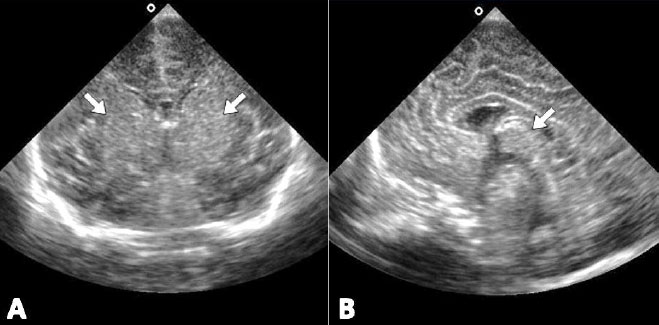Perinatology.
2016 Dec;27(4):251-254. 10.14734/PN.2016.27.4.251.
Brain Death in a Near-Term Infant: A Case Report
- Affiliations
-
- 1Department of Pediatrics, Cheil General Hospital & Women's Health Care Center, Dankook University College of Medicine, Seoul, Korea. ykleeped@hanmail.net
- KMID: 2367037
- DOI: http://doi.org/10.14734/PN.2016.27.4.251
Abstract
- Brain death is defined as the complete and irreversible loss of cerebral and brainstem function while the heart continues to beat. Unlike cardiac death, brain death is associated with medical, legal, and ethical issues. Common causes of neonatal brain death are perinatal asphyxia, birth trauma, cerebral infection, malformations, severe intracranial hemorrhage, and metabolic diseases. Although a diagnosis of brain death is usually based on clinical criteria, it is not well defined in neonates, especially in preterm babies. Furthermore, there are no guidelines on life expectancy, prolonging life care, or discontinuation of life support in brain dead newborns in Korea. We report a case of brain death due to hypoxic ischemic encephalopathy in a near-term newborn, present the need to establish guidelines for brain death in newborns based on national standards, and discuss further directions about end of life treatment after brain death.
Keyword
MeSH Terms
Figure
Reference
-
1. Parker BL, Frewen TC, Levin SD, Ramsay DA, Young GB, Reid RH, et al. Declaring pediatric brain death: current practice in a Canadian pediatric critical care unit. CMAJ. 1995; 153:909–916.
Article2. Sarnat HB, Sarnat MS. Neonatal encephalopathy following fetal distress. A clinical and electroencephalographics study. Arch Neurol. 1976; 33:696–705.3. Ashwal S, Serna-Fonseca T. Brain death in infants and children. Crit Care Nurse. 2006; 26:117–124. 126–128.
Article4. Ashwal S. Brain death in the newborn. Current perspectives. Clin Perinatol. 1997; 24:859–882.5. Nakagawa TA, Ashwal S, Mathur M, Mysore M. Society of Critical Care Medicine, Section on Critical Care and Section on Neurology of American Academy of Pediatrics. Child Neurology Society. Clinical report-guidelines for the determination of brain death in infants and children: an update of the 1987 task force recommendations. Pediatrics. 2011; 128:e720–e740.6. Ding ZY, Zhang Q, Wu JW, Yang ZH, Zhao XQ. A comparison of brain death criteria between China and the United States. Chin Med J. 2015; 128:2896–2901.
Article7. Gillson N, Weisleder P, Ream MA. A brain death dilemma: apnea testing while on high-frequency oscillatory ventilation. Pediatrics. 2015; 135:e5–e6.
Article8. Ahlawat A, Carandang R, Heard SO, Muehlschlegel S. The modified apnea test during brain death determination: an alternative in patients with hypoxia. J Intensive Care Med. 2016; 31:66–69.9. Wahlster S, Wijdicks EF, Patel PV, Greer DM, Hemphill JC 3rd, Carone M, et al. Brain death declaration: Practices and perceptions worldwide. Neurology. 2015; 84:1870–1879.
Article10. Internal Organs. . Transplant Act of 2013, Article 18 (Act No. 11976).11. Chatziioannidis I, Chouchou P, Nikolaidis N. Is brain death diagnosis in newborns feasible? Hippokratia. 2012; 16:308–311.12. Al-Shammri S, Nelson RF, Madavan R, Subramaniam TA, Swaminathan TR. Survival of cardiac function after brain death in patients in Kuwait. Eur Neurol. 2003; 49:90–93.
Article13. Shewmon DA. Chronic “brain death”: meta-analysis and conceptual consequences. Neurology. 1998; 51:1538–1545.
Article
- Full Text Links
- Actions
-
Cited
- CITED
-
- Close
- Share
- Similar articles
-
- Chronic Brain-Dead Patients Who Exhibit Lazarus Sign
- A Case of Incidentally Discovered Multiple Disseminated Fungal Brain Abscess in Asymptomatic Very Low Birth Weight Infant
- A Definition of Death Focusing on the Historical Background of Brain Death
- Preenhanced computed tomographic findings in brain death
- Therapeutic Hypothermia for Newborns with Hypoxic Ischemic Encephalopathy


